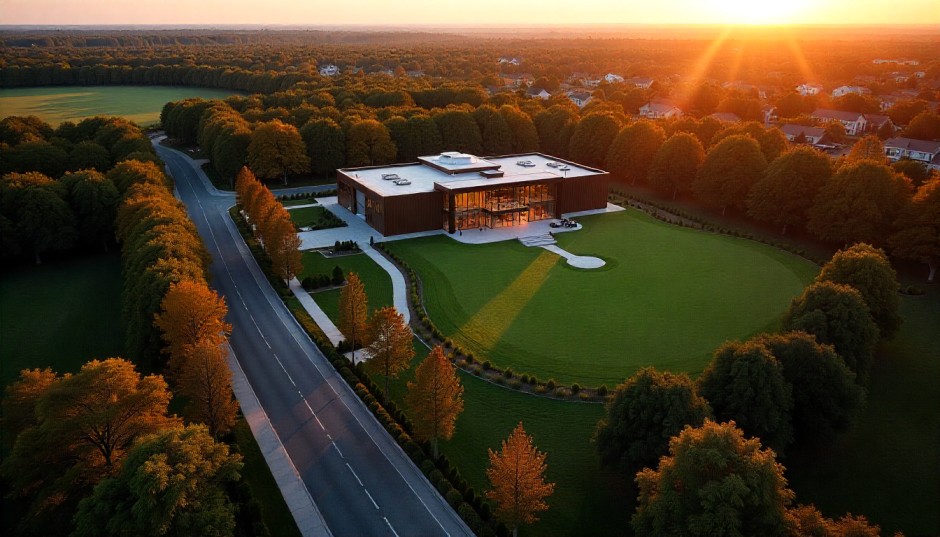
Blog
We keep you up to date on the most recent real estate news and events.
Centre Stage Living: What It Means to Own a Special Edition Plot
Owning a Special Edition plot is like getting a front‑row seat at centre stage. There are plenty of seats in the hall, but only a few that frame the performance just right. In Indian townships, that “just right” comes from a rare mix: tight curation, prime inside‑masterplan positioning, and access to a whole ecosystem of amenities most stand‑alone plots can only dream of. It’s limited by design, demanded by discerning buyers, and increasingly validated by how the premium housing wave is reshaping India’s residential market in 2024–25. That context matters because scarcity only works when demand is real.
What “Special Edition” really means
A Special Edition plot isn’t a random corner in a large layout. It’s a capped inventory inside a gated township—fewer numbers, curated features, and a location that commands centre‑stage sightlines to greens, clubhouses, parks, or boulevards by intent, not accident. In practice, developers release a very limited tranche with stricter design guidelines and premium frontage or corner positioning, often closest to the township’s flagship amenities. This is the difference between owning “inside a township” and owning the part that the master plan was built to highlight.
- Limited by design: Developers ring‑fence a small number to preserve exclusivity and maintain the experience entry sequence, carriageways, and landscape spec. That scarce supply is what underwrites long‑term value.
- Premium positioning: Proximity to core amenities like clubhouse, central park, primary gate, or signature streets mitigates future view‑loss and maximises daily convenience. This “centre of gravity” effect is a planned feature in modern gated communities.
- Elevated specs: Wider frontages, better street addresses, superior paving and lighting, and tighter façade/by‑law controls help maintain streetscape quality over time, typical differentiators in the premium tranche.
Why does the timing favour premium plots
India’s top end has been doing the heavy lifting. Through 2024–25, premium and luxury residential demand expanded, while mid-to-lower segments saw measured launches, pointing to both buyer appetite and developer focus on the upper tiers. That matters for Special Edition plots because the exit market for future buyers is deepening precisely where these plots are located.
- Price resilience: Knight Frank tracking shows sustained momentum as affordability improves; prime segments in cities such as New Delhi posted notable price growth in late 2024, signalling a larger base of buyers willing to pay for rare inventory.
- Demand composition: The luxury cohort has broadened beyond the ultra‑rich CXOs, founders, NRIs, professionals converging in gated precincts for lifestyle and security, keeping absorption healthy in premium‑positioned releases.
The lifestyle equation: more than a boundary wall
Special Edition plots turn privacy into a daily, lived luxury. The value isn’t just land area, it's the choreography around it: the approach, the neighbours, the noise profile, and how the day flows from home to clubhouse to green and back with minimal friction. India’s most reliable township formats lean into this model because it’s practical, repeatable, and aligned with what modern families want.
- Security as standard: Controlled entries, CCTV coverage, patrols, and digital access provide a safety baseline that legacy plotted colonies struggle to match consistently.
- Everyday convenience: Internal roads, lighting, drainage, landscaping, and professional facility management mean fewer battles with utilities, and comfort becomes predictable, which is a luxury in itself.
- Clubhouse as living room: Pools, gyms, co‑working lounges, and community halls turn weekends and evenings into low‑effort leisure. The walkable radius becomes the lifestyle.
Privacy engineered, not improvised.
Exclusivity in Special Edition plotting is intentionally engineered. Wider setbacks, limited through‑traffic, greener buffers, and design controls reduce overlook and noise. Corner plots with dual access or green-front positions offer more light, better ventilation, and room for a layered landscape that screens without encroaching on the space. This is privacy that reads elegant, not aloof.
- Quiet by planning: Cul‑de‑sacs, speed‑calmed streets, and perimeter planting lower ambient disturbance, keeping evenings and early mornings serene.
- Neighbourhood integrity: With unified guidelines, façades age better together; no visual jarring from ad‑hoc extensions or jumbled frontages is key to preserving premium over time.
The RERA lens: confidence built into the product
For plotted townships with promised infrastructure and shared amenities, RERA registration is now the norm. Under the Real Estate (Regulation and Development) Act, 2016, such projects must register, disclose approvals, adhere to timelines, and ring‑fence funds in escrow protections that de‑risk Special Edition buyers versus legacy plotted colonies.
- When plots trigger RERA: If a developer offers internal roads, utilities, parks, security, or a clubhouse within a plotted scheme, the project becomes a “real estate project” and must be registered with the relevant State RERA before sale or marketing.
- What registration assures: Layout plans, title clarity, timelines, and 70% project funds escrowed, plus buyer rights to information and grievance redressal, all tracked by the authority.
- Why this matters for premiums: Buyers paying for exclusivity also pay for predictability. RERA compliance aligns execution with promise, reducing the risk that undermines luxury value.
Amenities that justify the premium
The most convincing premiums feel unarguable at 7 am and 7 pm alike. In high‑quality Indian gated layouts, the “daily route” is short: doorstep greens, a gym without traffic, a pool without a membership hoop, and cafés or lounges that extend the living room when guests arrive. Special Edition plotting often sits closest to this spine.
- Health built‑in: Jogging tracks and sports courts within a 3–5 minute walk turn intent into habit; residents use what they can reach.
- Social fabric: Amphitheatres, lawns, and community rooms host festivals and clubs; real friendships are part of the value proposition, not an afterthought.
- Facility management: Centralised upkeep keeps the township neat year‑round, translating into comfort and valuation integrity.
How scarcity shows up in numbers
Scarcity is most effective when the audience is growing. Over 2024–25, India’s luxury housing sales rose sharply across major cities, with strong momentum in the ₹4 crore-plus bracket reported by industry trackers, indicating a depth of demand on the part of buyers for limited, high-spec inventory. For Special Edition plots, that’s the rising tide every seller wants behind them.
- Premium price appreciation: Prime‑city indices in late 2024 placed New Delhi among the top global gainers for luxury price growth, validating the appetite for marquee addresses where scarcity is absolute.
- Developer focus: Launch pipelines skew mid‑to‑upper end, concentrating innovation and capital where premium buyers are most active, a sign that Special Edition releases won’t be in oversupply.
Who buys Special Edition and why they hold
Two profiles dominate: end-users who lead with lifestyle considerations (such as privacy, safety, amenities, and school access), and long-term investors who treat address and micro-location as an asset class. Both value the narrative attached to a limited series: the entry sequence, the central green, and the clubhouse viewed across a tree line. They also value the discipline that keeps that narrative consistent.
- End‑user calculus: Daily convenience and social life without a commute; a safe, managed environment for children and elders; and a home canvas big enough to personalise without losing community coherence.
- Investor calculus: Liquidity tends to concentrate around the best‑located precincts within successful townships, especially when the premium tranche is visibly scarce and well‑kept.
How to evaluate a Special Edition plot
Treat due diligence like a designer would: study how the plot “performs” throughout the day, under various lighting conditions, wind, and noise, then layer in the regulatory and financial hygiene.
- Orientation and frontage: Corner, green‑front, or boulevard‑facing plots with more expansive frontage and controlled opposite frontage generally age better in value.
- Amenity distance: A 3–6 minute walk to the clubhouse or central park without a major road crossing is a real premium; it’s what residents use daily.
- RERA and disclosures: Verify the RERA registration number on the State portal; check sanctioned layout, approvals, escrow details, timelines, and the exact Special Edition inventory map.
- Facility management: Review the FM scope, landscaping cycles, security staffing, street‑lighting SLAs, and clubhouse operating hours. This is the invisible engine that keeps the premium obvious.
Designing the home to match the canvas
The best Special Edition homes read the plot and respond. Think low walls and layered greens for privacy without bulk, deep verandahs to catch the breeze, and window placements that frame neighbourhood views without peering into someone else’s dinner. The township design guidelines exist to protect these choices, embrace them and keep the street beautiful and the valuations steady.
- Inside‑outside living: Oversized sliders to decks, pergolas, and pocket courts extend usable area in shoulder seasons. A true luxury when privacy is already compromised outside.
- Material calm: Quiet palettes and robust finishes weather better in curated streetscapes, letting landscape and light do the talking. Timeless wins in resale.
The bottom line: centre‑stage living
A Special Edition plot inside a luxury township is the sweet spot between independence and orchestration. It delivers a home canvas large enough to personalise, a neighbourhood refined enough to feel quietly exclusive, and an amenity spine strong enough to make weekends effortless. Above all, it is limited by intent. In a market where India’s premium housing demand has been rising and prime city prices have proved resilient, that kind of engineered scarcity isn’t marketing—it’s strategy. And it pays off daily, every time the gate closes gently behind, the street stays calm, and the clubhouse lights up at the end of a short, tree‑lined walk.